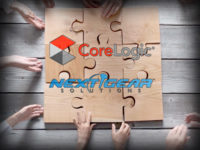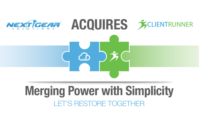A Major Merger: Why Next Gear & ClientRunner Decided to Join Forces

In June, Next Gear Solutions announced the acquisition of its biggest competitor, ClientRunner. The goal was to create a platform unrivaled in the restoration industry - harnessing the power and robustness of DASH and its clear industry leadership in job management software, with ClientRunner's simplicity.
What happens when two companies that have spent the last few years competing with one another? How do they come together to unite for a common purpose? What are the pitfalls and benefits from this process and what lessons can restoration contractors take away from these software leaders merging? I sat down with Garret Gray, the CEO of Next Gear Solutions, and Scott Severe, former CEO of ClientRunner and now CSO of Next Gear Solutions, to find the answers to those questions and more.
I think the question on everyone's mind is "why merge"?
Garret Gray: Scott and I get this question all the time. As the two biggest players in the market we had a good time competing with each other, and deciding to stop competing and work together was no easy decision initially. The first step was figuring out if the two of us could work together for the next several years. Would we be able to unite both companies, our technologies, and client base in a way that would benefit the industry as a whole? The answer we both got to pretty quickly was yes, absolutely. This exciting combination would offer a such a tremendous value to our customers and prospects in such a short amount of time that we knew we had to make it happen. Once we believed it was the right move for everyone the real work started.
Scott Severe: ClientRunner was struggling to keep up with all of the features DASH was releasing and our choices to catch up were limited. On the other hand, our laser focus on simplicity was an advantage we knew Next Gear could leverage. Both companies approached our solutions for the market differently, and merging them together was a winning combination in my estimation. Bottom-line, if we could work together, we could really change the game in the industry we serve and that was/is exciting to me.
Mergers like these fail more often than not. What makes this different?
SS: If you look at most failed mergers you will see that culture integration, or lack thereof, plays a huge role. Even though our two companies were very different in market strategy, our cultures were actually very similar. What I have been encouraged the most with is the focus on merging our two cultures and how welcoming the Next Gear team has been. This merger has been and will continue to be successful because we have all made culture a priority.
GG: When you bring two companies together like we have, there are several cultural land mines to watch out for. When one company acquires another, the team from the company doing the acquiring can easily feel a sense of conquering or superiority to the team being acquired. This sentiment must be destroyed and turned on its head quickly or cultural unity will never be achieved. Effective mergers should be viewed like a marriage where two individuals unite as one after living two separate lives. While each come into the marriage with strengths and weaknesses, leveraging the best parts of each will yield the best results for all involved. I think both Scott, myself, and our teams got behind this approach right away and it's the reason for the speed at which we have merged our teams.
What are some practical pieces of advice you can give contractors that are thinking about a possible merger?
GG: Ambiguity is not your friend. Having a clarity between the principle players, employees, and customers is key to properly setting expectations, which is the foundation of a successful merger.
What is next for this new, bigger Next Gear – and for restoration companies currently using ClientRunner?
GG: Well, I don’t expect this to be the last acquisition for Next Gear, with possible announcements coming before the end of the year. We believe in competition but also believe the level of fragmentation in the industry is not serving contractors well. So we hope to do our part to bring the industry together while also improving what type of solutions we can offer our clients. ClientRunner clients have already seen the changes the Next Gear team can bring. We have brought increased stability to the platform and we are working to merge what is best about each platform over the coming months. ClientRunner customers now have the benefit of 24/7/365 live support and we expect to bring additional benefits now that they are part of the Next Gear family.
Mobility has seen explosive growth among restoration contractors in recent years. What technology do you expect to see explode next?
GG: We believe Mobility is still in it’s infancy. You can expect to continue to see huge innovation in the mobile space from Next Gear. I think other interesting technologies are several years away but for now, mobile job processing is where innovation is making the biggest difference and will for a few years to come.
What is your #1 tip for getting that one final person who refuses to adopt a software/technology change to finally come on board?
SS: It may never feel like there is a good time to make such a significant change. Getting on board with robust job management software that is integrated with the prevalent industry packages and programs is truly transformative. I mean, we have seen companies do amazing things over short periods of time after adopting solid software solutions. Of course there is always some pain in adopting software or technology but what I love about Next Gear is we have dedicated the resources to make that transition easy. This time next year you will wish you had stared the transition today.
GG: I think it is important to understand and communicate well the reason why technology or a new software is something your company is embracing. If you or your team have a competitive spirt, focus on beating your competition and raising the bar in your market. If rising above the mound of paper or getting better visibility is your driving need, make sure the entire team understands how this change will solve issues that are currently holding the team back. Understanding and talking about the “why” goes a long way to helping people manage the change.
Looking for a reprint of this article?
From high-res PDFs to custom plaques, order your copy today!






